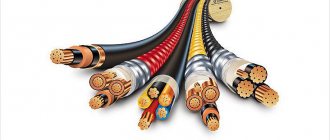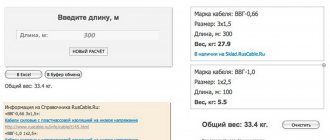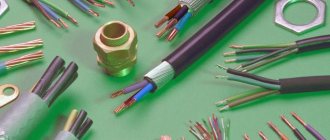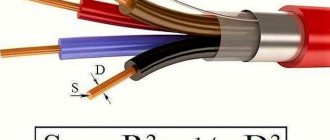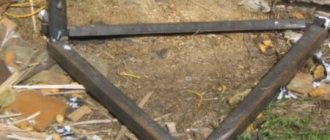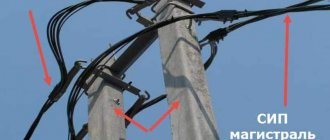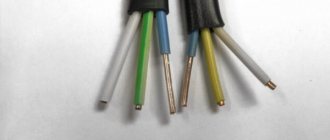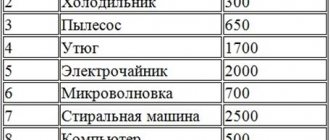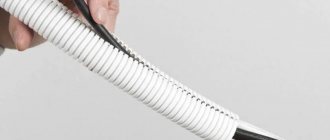In theory, the diameter of the conductors should correspond to the declared parameters. For example, if the marking indicates that the cable is 3 x 2.5, then the cross-section of the conductors should be exactly 2.5 mm2. In fact, it turns out that the actual size may differ by 20-30%, and sometimes more. What does this mean? Overheating or melting of insulation with all the ensuing consequences. Therefore, before purchasing, it is advisable to find out the size of the wire in order to determine its cross-section. We will find out further how to calculate the wire cross-section by diameter.
How and with what to measure the diameter of a wire (wire)
To measure the diameter of the wire, a caliper or micrometer of any type (mechanical or electronic) is suitable. It’s easier to work with electronic ones, but not everyone has them. You need to measure the core itself without insulation, so first move it aside or remove a small piece. This can be done if the seller allows it. If not, buy a small piece to test and take measurements on it. On a conductor stripped of insulation, measure the diameter, after which you can determine the actual cross-section of the wire from the found dimensions.
Measuring wire diameter with a micrometer is more accurate than with a mechanical caliper
Which measuring device is better in this case? If we talk about mechanical models, then a micrometer. Its measurement accuracy is higher. If we talk about electronic options, then for our purposes they both give quite reliable results.
If you don't have a caliper or micrometer, take a screwdriver and a ruler with you. You'll have to strip a fairly decent piece of conductor, so you'll hardly be able to do without buying a test sample this time. So, remove the insulation from a 5-10 cm piece of wire. Wind the wire around the cylindrical part of the screwdriver. Lay the coils close to each other, without a gap. All turns must be complete, that is, the “tails” of the wire must stick out in one direction - up or down, for example.
Determining wire diameter using a ruler
The number of turns is not important - about 10. You can have more or less, it’s just easier to divide by 10. Count the turns, then apply the resulting winding to the ruler, aligning the beginning of the first turn with the zero mark (as in the photo). Measure the length of the section occupied by the wire, then divide it by the number of turns. You get the diameter of the wire. It's that simple.
For example, let's calculate the size of the wire shown in the photo above. The number of turns in this case is 11, they occupy 7.5 mm. Divide 7.5 by 11, we get 0.68 mm. This will be the diameter of this wire. Next, you can look for the cross section of this conductor.
Conductor materials
The amount of energy that a conductor transmits depends on a number of factors, the main one of which is the material of the current-carrying conductors. The following non-ferrous metals can be used as the core material of wires and cables:
- Aluminum. Cheap and lightweight conductors, which is their advantage. They are characterized by such negative qualities as low electrical conductivity, a tendency to mechanical damage, high transient electrical resistance of oxidized surfaces;
- Copper. The most popular conductors, which have a high cost compared to other options. However, they are characterized by low electrical and transition resistance at the contacts, fairly high elasticity and strength, and ease of soldering and welding;
- Aluminum copper. Cable products with aluminum cores coated with copper. They are characterized by slightly lower electrical conductivity than their copper counterparts. They are also characterized by lightness, average resistance and relative cheapness.
Some methods for determining the cross-section of cables and wires will depend specifically on the material of their conductor component, which directly affects the throughput power and current strength (method of determining the cross-section of conductors by power and current).
We are looking for the wire cross-section by diameter: formula
The wires in the cable have a circular cross-section. Therefore, when calculating, we use the formula for the area of a circle. It can be found using radius (half the measured diameter) or diameter (see formula).
Determine the cross-section of the wire by diameter: formula
For example, let's calculate the cross-sectional area of the conductor (wire) based on the size calculated earlier: 0.68 mm. Let's use the radius formula first. First we find the radius: divide the diameter by two. 0.68 mm / 2 = 0.34 mm. Next, we substitute this figure into the formula
S = π * R2 = 3.14 * 0.342 = 0.36 mm2
You need to calculate it like this: first we square 0.34, then multiply the resulting value by 3.14. We obtained a cross-section of this wire of 0.36 square millimeters. This is a very thin wire that is not used in power networks.
Let's calculate the cable cross-section by diameter using the second part of the formula. It should be exactly the same value. The difference may be in thousandths due to different rounding.
S = π/4 * D2 = 3.14/4 * 0.682 = 0.785 * 0.4624 = 0.36 mm2
In this case, we divide the number 3.14 by four, then we square the diameter and multiply the two resulting numbers. We get a similar value, as it should be. Now you know how to find out the cable cross-section by diameter. Whichever of these formulas is more convenient for you, use that one. No difference.
About choosing a cable brand for home wiring
Making apartment electrical wiring from aluminum wires at first glance seems cheaper, but operating costs due to low reliability of contacts over time will be many times higher than the costs of electrical wiring made from copper. I recommend making the wiring exclusively from copper wires! Aluminum wires are indispensable when laying overhead electrical wiring, as they are light and cheap and, when properly connected, serve reliably for a long time.
Which wire is better to use when installing electrical wiring, single-core or stranded? From the point of view of the ability to conduct current per unit of cross-section and installation, single-core is better. So for home wiring you only need to use solid wire. Stranded allows multiple bends, and the thinner the conductors in it, the more flexible and durable it is. Therefore, stranded wire is used to connect non-stationary electrical appliances to the electrical network, such as an electric hair dryer, an electric razor, an electric iron and all the others.
After deciding on the cross-section of the wire, the question arises about the brand of cable for electrical wiring. The choice here is not great and is represented by only a few brands of cables: PUNP, VVGng and NYM. PUNP cable since 1990, in accordance with the decision of Glavgosenergonadzor “On the ban on the use of wires such as APVN, PPBN, PEN, PUNP, etc., produced according to TU 16-505. 610-74 instead of APV, APPV, PV and PPV wires according to GOST 6323-79*" is prohibited for use.
Cable VVG and VVGng - copper wires in double polyvinyl chloride insulation, flat shape. Designed for operation at ambient temperatures from −50°С to +50°С, for wiring inside buildings, outdoors, in the ground when laid in tubes. Service life up to 30 years. The letters “ng” in the brand designation indicate the non-flammability of the wire insulation. Two-, three- and four-core wires are available with core cross-sections from 1.5 to 35.0 mm2. If in the cable designation there is a letter A (AVVG) before VVG, then the conductors in the wire are aluminum.
The NYM cable (its Russian analogue is the VVG cable), with copper cores, round in shape, with non-flammable insulation, complies with the German standard VDE 0250. Technical characteristics and scope of application are almost the same as the VVG cable. Two-, three- and four-core wires are available with core cross-sections from 1.5 to 4.0 mm².
As you can see, the choice for laying electrical wiring is not large and is determined depending on what shape the cable is more suitable for installation, round or flat. A round-shaped cable is more convenient to lay through walls, especially if the connection is made from the street into the room. You will need to drill a hole slightly larger than the diameter of the cable, and with a larger wall thickness this becomes relevant. For internal wiring, it is more convenient to use a VVG flat cable.
When laying apartment electrical wiring, as a rule, the question arises about choosing a circuit breaker, or, as it is often called, a machine. This issue and the choice of a meter, RCD, and differential circuit breaker are covered in detail in the website article “About the electric meter, RCD and circuit breakers.”
Table of correspondence of wire diameters and their cross-sectional area
You don’t always want or have the opportunity to make payments in a store or on the market. In order not to waste time on calculations or to avoid making mistakes, you can use the table for the correspondence of diameters and cross-sections of wires, which contains the most common (normative) sizes. You can rewrite it, print it and take it with you.
| Conductor diameter | Conductor cross-section |
| 0.8 mm | 0.5 mm2 |
| 0.98 mm | 0.75 mm2 |
| 1.13 mm | 1 mm2 |
| 1.38 mm | 1.5 mm2 |
| 1.6 mm | 2.0 mm2 |
| 1.78 mm | 2.5 mm2 |
| 2.26 mm | 4.0 mm2 |
| 2.76 mm | 6.0 mm2 |
| 3.57 mm | 10.0 mm2 |
| 4.51 mm | 16.0 mm2 |
| 5.64 mm | 25.0 mm2 |
How to work with this table? As a rule, the cables have a marking or tag indicating its parameters. The cable marking, number of cores and their cross-section are indicated there. For example, VVNG 2x4. We are interested in the core parameters and these are the numbers that appear after the “x” sign. In this case, it is stated that there are two conductors having a cross section of 4 mm2. So we will check whether this information corresponds to reality.
How to work with a table
To check, measure the diameter using any of the described methods, then check the table. It states that with such a cross-section of four square millimeters, the wire size should be 2.26 mm. If your measurements are the same or very close (there is a measurement error, since the devices are not ideal), everything is fine, you can buy this cable.
Stated sizes do not always correspond to real ones
But much more often, the actual diameter of the conductors is much smaller than the declared one. Then you have two options: look for a wire from another manufacturer or take a larger cross-section. Of course, you will have to overpay for it, but the first option will require a fairly long period of time, and it is not a fact that you will be able to find a cable that complies with GOST.
The second option will require more money, since the price significantly depends on the declared cross-section. Although, it’s not a fact - a good cable made according to all standards may cost even more. This is understandable - the cost of copper, and often also for insulation, subject to technology and standards, is much higher. That’s why manufacturers cheat by reducing the diameter of the wires in order to reduce the price. But such savings can turn into disaster. So be sure to take measurements before purchasing. Even trusted suppliers.
And one more thing: inspect and feel the insulation. It should be thick, continuous, and have the same thickness. If, in addition to changing the diameter, there are also problems with insulation, look for a cable from another manufacturer. In general, it is advisable to find products that meet the requirements of GOST, and not made according to specifications. In this case, there is hope that the cable or wire will serve for a long time and without problems. It's not easy to do these days, but whether you're wiring your home or running electricity from a utility pole, quality is very important. Because it’s probably worth looking for.
Why do you need to calculate the cable load?
This question often arises when installing wiring in an apartment or home. First, all planned loads are considered, and then the required wire cross-section is determined. Then the necessary material is purchased from the store and electrical wiring is installed in the house.
As a result of using new wiring, the circuit breaker on the electrical panel first “knocks out”, and then damage to the wire is discovered. Moreover, it often turns out to be completely melted, as a result of which a short circuit occurs. It turns out that the calculations were made incorrectly, and how can you find out the minimum permissible value of the wire cross-section in this case?
To avoid serious overloads, it is necessary to calculate how many electrical appliances in the apartment will be used simultaneously. Among the most powerful household appliances that are usually used at home when preparing food and creating our comfort are:
- electric stove;
- air conditioner;
- microwave;
- electric kettle;
- iron;
- washing machine and dishwasher;
- coffee grinder;
- vacuum cleaner.
The power consumption of these household appliances ranges from 1 to 2 kilowatts (with the exception of electric stoves).
Important! If the cross-section of the wire is indicated incorrectly (underestimated), then when using it, it is natural for large overloads to occur, which lead to a fire in the wiring.
How to determine the cross-section of a stranded wire
Sometimes stranded conductors are used - consisting of many identical thin wires. How to calculate the cross-section of the wire by diameter in this case? Yes, exactly the same. Carry out measurements/calculations for one wire, count their number in the bundle, then multiply by this number. So you will find out the cross-sectional area of the stranded wire.
The cross-section of a stranded wire is calculated similarly
Design features of the electrical wire
The design of any electrical wire contains cores. These are the main elements of the cable. Each of them has a shell. It is internal insulation. Current is transmitted directly through the veins. Any number of them is contained in a common outer protective shell. The number of cores is always taken into account when deciding which cable to choose for wiring in the house.
In addition to current-carrying elements, their insulating protection, and the outer sheath, the design of an electrical cable may also contain additional components. For example, this is the internal common shell. It is located in the wire between the outer protective layer and the insulated conductors. The electrical cable may also have armor made of wire or steel.
Structure of an electrical cable Source elektrikii.ru
Manufacturers produce electrical wires with cores that can be solid single-wire. Cables consisting of multi-wire conductive elements are also produced. Such veins are made from a large number of thin threads.
Important! Do not confuse a single-core electrical wire with a single-wire conductive element. After all, a single core in an electrical cable can consist solely of one or several wires twisted together.
Professionals choose electrical wiring for their home based on their experience. They take into account the level of ease of working with it. Experts also take into account what material the electrical cable cores are made of. After all, manufacturers make conductive elements of electrical wires from aluminum or copper.
When comparing these metals, it is noted that aluminum conductors make it possible to produce cheaper cables. However, such wires are characterized by lower electrical conductivity. Therefore, with the same cross-sections, copper wires will pass more electric current.
Wires with aluminum conductors have low electrical conductivity Source lomrf.ru
Copper wiring also has one disadvantage. It lies in the impossibility of a high-quality direct connection of copper with another metal. In other words, special adapters are used to connect copper and aluminum wiring. They are used to prevent the formation of a galvanic couple at the junction.
On a note! Experts believe that aluminum cables are not the best option for home electrical wiring. This is due precisely to their low electrical conductivity. In addition, electrical cables made of aluminum can quickly oxidize and break at bending points.
If wires made of different materials are twisted together, then oxidation of the junction will occur. Therefore, the contact between the electrical cables will disappear, which will lead to a short circuit in the electrical network.
Important! It is necessary to use the same type of wiring cable throughout the house.
Manufacturers produce wires with general protective insulation, for the manufacture of which the following is used:
- polyethylene;
- rubber material;
- polyvinyl chloride
Electric cable with polyvinyl chloride protection Source pskabel.ru
Any cable for wiring in the house is produced with an outer sheath, which has high insulating properties. The outer braid provides reliable protection against water. Modern wires are used to create electrical networks of various classes with a maximum voltage of 500 V.
See also: Catalog of companies that specialize in electrical work of any complexity
Popular electrical cables for the home
When a specialist decides which cable to use for wiring in a house, he, first of all, focuses on existing types of wires. An important selection criterion is the number of cores required. Many manufacturers produce cables with 1-5 conductive elements. Such products have different purposes. Therefore, it is necessary to consider the main common types of wires for electrical wiring in private residential buildings.
Type 1 – VVG cable
When laying in-house electrical wiring, including installation of an electrical network using distribution boxes, VVG cable is often used. It is through it that current is transmitted. It can withstand a maximum voltage of 1000 V. Manufacturers produce this current conductor with cores, the number of which does not exceed 5 pieces.
Four-core electrical cable VVG Source files.glotr.uz
For VVG products the cross-section can be:
- flat;
- round;
- square;
- triangular.
The advantages of VVG electrical cables include the wide temperature range at which these products are used. For such current conductors it ranges from -50 to +50 ℃. Electrical wires of this type can withstand high breaking loads. They are also renowned for their ability to be used in environments that are 98% critical.
Electric cable VVG can be designated as follows:
- NG – insulating shell that does not support the combustion process;
- Z – the presence of rubber material or polyvinyl chloride bundles between the external protection and the insulated conductors;
- P – flat wire.
On a note! VVG cable for electrical wiring, with the exception of the wire with the letter “Z”, is manufactured without filling the space that is located between the insulated conductors and the external protection.
Three-core electrical cable VVG with empty space between the outer sheath and the insulating material of each current-carrying core Source kemerovo.tdsevcable.ru
When creating home electrical lines, a wire marked VVGng-LS is often used. Such products meet all safety criteria and are sold at an affordable price. Its insulation contains a minimum of halogens. Therefore, the wire burns and smolders more slowly. This makes it possible to inhale less dangerous doses of toxic substances during a fire. In addition, people will be able to evacuate longer.

